It was 5,133 miles – 47 days. It was my longest passage yet, from Linton Bay in Panama to Douglas, Isle of Man.
Without stopping.
And it was fairly eventful – which is why, a full two weeks after arriving, I am only just now sitting down to write this.
But then the whole trip happened in a bit of a rush: I was just back from the family skiing holiday in Italy where, sitting at a mountain restaurant at the foot of the Matterhorn, I had reminded everyone about the plan to meet up again in the Azores in July.
“Oh no,” said Tamsin. She couldn’t. She was going to Vietnam in June to visit Lottie (Lottie is teaching English to little Vietnamese children). Tamsin wouldn’t have enough holiday from her new job to spend a week in the Azores.
Thinking on my feet, I came up with: “How about a weekend in Dublin?” There were people round the table who had never been to Dublin. Dublin sounded great – so Dublin it is, sometime in August, maybe…
We settled to ordering Tartiflette and Fonduta Valdostana,
It was only when I got back to Panama and Ramón, the taxi driver, had negotiated the final two miles of dirt tracks to the little French enclave of Panamarina (really – they all speak French and there is a proper French restaurant) that I began to think of the logistics.
I had plenty of time – it was only early April after all. But Donald Trump was talking about “taking back” the Panama Canal, and it would be just my luck to get stuck there with a State of Emergency. Also, if I were to sail all the way without stopping, it would be good material for another “Voyage” book – and I needed one: Old Man Sailing had sold 13,000 copies since I published it on Amazon in 2021. But sales were tailing off and, quite frankly, I needed the money.
The “Voyage” books were a success, but there were only two of them, and you can’t decently have a series with less than three. The more I looked at it, the longer I spent poring over the Navionics chart and the relative benefits of the windward and leeward passages around Cuba, the more the idea started to become a reality – and the thing with reality is that you want it to get on and become one as soon as possible.
And then, for some reason I can’t quite pin down, I thought of sailing straight to the Isle of Man for the TT. I tried to get there years ago – I once had a BSA Bantam (and nearly killed myself on Streatham High Road). I wouldn’t dream of riding a motorcycle now. But I do love to see them – and hear them. Hearing them between rain squalls while anchored in Ramsey Bay was all I managed last time. But if I were to leave now – well, as soon as possible – I might just make it for the last weekend. It would be a challenge (which would add a frisson of excitement to the narrative). All I had to do was sail 100 miles a day for 50 days.
I left on Wednesday, April 17th – it would have been the 16th, but Fausto, the immigration man, had to go to Panama City to get me my Zarpe – the essential exit permit.
And so, with a bilge full of beer, several dozen tins of beans and, by oversight, only six sheets of kitchen roll, I set off into a northeasterly Force 4-5 with a “Distance to Destination” of 5,166 miles.
The fact that I shaved off 33 of them had something to do with ignoring the advice to stay 130 miles off the coast of Nicaragua because the fishermen are now so hard up, they’re not averse to a little amateur piracy. On April 17th, I was 66 miles off Cabo Gracias a Dios in only 12 metres. I blame some idiotic competitive spirit.
The whole point in choosing the leeward passage – going between Cuba and the Yucatan peninsula of Mexico – is to ride the Gulf Stream through the Florida Strait. The downside is that it’s a beat all the way, and if the Tradewind is blowing at its full Force 5-6, that’s 350 miles of wind over tide. I’m ashamed to say, I revelled in every cable of it – there is something ineffably wonderful about looking at your track on the screen and seeing that you’ve been tacking through an obtuse angle (check it at https://www.polarsteps.com/JohnPassmore/15574045-2025).
But if I thought that was pretty exciting, wait ‘til I got to the east coast of Florida. Somewhere off West Palm Beach. I sat at the chart table filming the plotter as the “speed over the ground” hovered around ten knots and once, for a memorable second or two, flicked up to 12.1! I could get used to this…
And that’s the trouble. Once you get into the Gulf Stream, it’s hard to leave. Why would you want to? Sea that really is aquamarine, sky the very definition of sky blue, and a screaming beam reach – it’s sailing straight out of the charter company brochures. I recorded no fewer than three 150-mile days – that’s an average of 6.25kts. In all, I was to have 27 days when I clocked more than 100 miles over the 24 hours. At one point, the average was 123.9.
And this included one inexplicable day of total calm, 60 miles off Cape Canaveral. Actually, this was no bad thing: One of the reasons for getting the Remigo electric outboard is because I plan to get a bracket made for the stern. The company website features a 23-footer powering along with one on the back. I reckon it could keep Samsara going at a knot or two, and that’s all you need to keep water flowing over the keel and stop the awful rolling as the ocean reminds you that it never sleeps – no matter what the wind might be doing.
But first, I had to establish that the 1,000W motor could push a 32-footer. I inflated the dinghy, lashed it alongside and pressed the “forward” button of the remote control.
Silently, the motor began to push the Caribbean behind it. Another press of the button, and we were making progress.
I am pleased to say that I managed to record a speed of 1.7kts – hardly surprising since the Remigo has, in the short period I’ve had it, demonstrated five knots (I found it really quite frightening). However, lash it to five tonnes of becalmed yacht, and it tries to launch the dinghy into space – rather appropriate, given where we were – but not much use for progress through the water. Most of the thrust was directed downwards. I was glad when the wind came back.
And the wind took me racing all the way up the east coast of the United States – the Carolinas, Virginia, Delaware, New Jersey. On May 11th, Day 26, the daily average hit 123.9 miles. By then, we were just inside the tail of the Grand Banks.
The next day, I broke the Aries. This redoubtable mechanical self-steering gear, built in the 1980s – the same model I had on my old Rival Largo – I always considered to be indestructible. However, in trying to match old and new parts, I may have made a miscalculation. The servo-oar hit something, and the sacrificial sleeve didn’t break fast enough. The main shaft bent, and it wouldn’t work anymore.
I did wonder what it had hit – and how big and immovable that object must have been to do so much damage. Could it have been a small ice floe – a “growler”? The water temperature was down at 1°C – and what would that have done to the hull if the course had deviated just a few inches to starboard…
Anyway, I spent the best part of a day getting the gear aboard (it weighs nearly 23kg) and trying to fix it. When I put it all back, it just wanted to take us round in circles.
This left me with 1,899 miles still to go and having to rely on the electronic autopilot. I have written a lot about electronic autopilots in the past, and my very low opinion of them. But this was based on my experience with the cheap little tillerpilot, which has all its electronics out in the cockpit. Every time it rained, I had to pay £70 for a new circuit board.
When Samsara had her 50th birthday refit in Conwy in 2023, Dave Jones of Advanced Tech Marine installed the much more sophisticated Raymarine Evolution system for me. It was very expensive, appeared to be most complicated, and its various components were secreted all around the boat, connected by miles of wire. But it steered faultlessly all the way home.
Well, there is a caveat with that. Because it has to “think”, the autopilot is not as quick to react as the Aries, which transmits the movement of the vane to the movement of the rudder instantly – all the forces being connected by aluminium castings and Dyneema line. Besides, once the autopilot’s electronic brain has done its “thinking”, the electric “muscle” of the steering ram has to grind its way across the cockpit. It all takes time – and, in a blow, it all takes far too long.
And we did get a blow.
In fact, I had three full gales with wind speeds over 34kts. I never saw the dial at more than 38kts. But they were very useful for experimenting.
In the first one, I wanted to see if I could get the boat to heave-to and drift directly downwind. When I had tried it before, she had fore-reached and sailed out of the protective slick which Lin Pardey talks about in her storm management books. This time, I streamed the SeaBrake drogue from the bow, and it worked brilliantly. It held the bow up between 45° and 60° to the wind, to take the full force of the waves, and yes, we did drift sideways. However, I didn’t think much of the slick. If it had been as effective as Lin promised, there wouldn’t have been any breaking waves – maybe it had something to do with her boats having full keels and the Rival design only a long fin. Still, I sat there for 12 hours, reading, cooking, and sleeping in relative comfort.
Only later did I discover that I shouldn’t have led the line for the drogue through a fairlead. The force of those breaking waves bent the screws and split the teak toe-rail. The SeaBrake is supposed to collapse and “give” when a sudden strain comes on it. Obviously, not enough.
The second gale saw us lying to the drogue set on a bridle off the stern. This was not a huge success. The boat still needs to be steered, and the autopilot, with its limited range, couldn’t really handle it. This gale lasted well over twelve hours, and at the end of it, the circle of rigging wire which holds the drogue open (and distorts to allow it to collapse under strain) had been strained so much that it had broken. Also, the material had chafed through where it rubbed on the webbing bridle.
The third gale was a bit more awkward because we were coming up to the northwest coast of Ireland, and I didn’t want to get any closer. Fortunately, weather forecasts via Starlink suggested this was going to be short-lived, but even so, I had to sit in the cockpit for three-and-a-half hours and steer through it with waves crashing over me and filling the cockpit above the top of my boots.
You would think this would be enough for one passage, but look what happened when we got into the Traffic Separation Scheme: At half-past two in the morning, with a cruise ship coming up behind, there was an almighty bang and the headsail fell over the side. The forestay had parted at the top.
Of course, I didn’t know this at the time. I was too busy rigging the removable inner forestay before the mast fell down. This wire terminates at the masthead, and not only kept everything upright, but I could set a staysail and keep sailing. This was even more important because, among other setbacks, the engine wouldn’t run for more than five minutes without overheating.
So that’s why it’s taken me two weeks to get around to writing this – that and the broken pump for flushing the watermaker – and, of course, the TT: Believe me, until you have leaned over a wooden garden fence and experienced a motorbike flashing by virtually within touching distance, doing something over 160 miles an hour, you really don’t know what excitement is all about.
-

-
Planning meeting
-
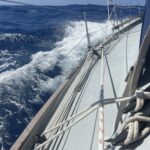
-
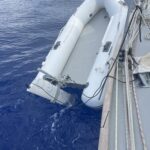
-
The Remigo trying to take off from Cape Canaveral
-
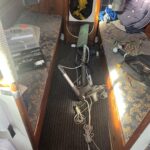
-
Fixing the Aries – not
-
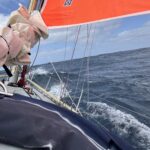
-
Hove to in the first gale
-
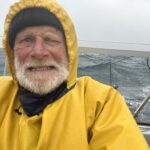
-
Cold and wet after the last one
-
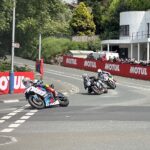
-
Real excitement




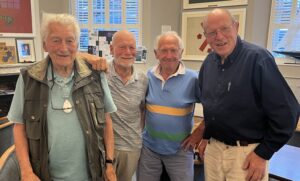







Thanks as always Sir, always entertaining as well as informative – and pleasing to see you are a Nevil Shute fan, my favourite author of other than blogs – I have links to him by association with close others, as does my club Langstone Sailing Club though at 63 I’m probably the only one there who’s ever heard of him. I take it you know the connection between the classic if harrowing ‘ Once Is Enough ‘ by Miles & Beryl Smeeton – which NS Norway wrote the original foreword for – and his last, most optimistic book ‘ Trustee From The Toolroom ‘. Snag is, courtesy of messers Trump & Putin we may have to go though ‘ On The Beach ‘ first…Fair winds, love your work – might even have found a girlfriend who agrees ! Andy